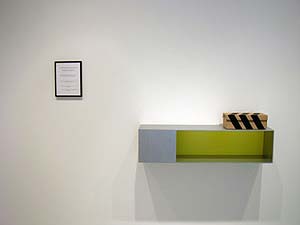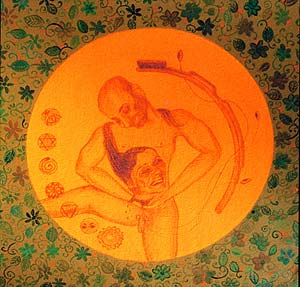Is there an avant-garde? I think I saw one last week. As the gallery machine churned to life in the first holiday-free weekend of September, Houston galleries bloomed with downtown artists showing in galleries and wandering within their white walls. Sprinting through the East side of "what matters," I was able to get a glimpse of the directions Houston art is going in.
On Main Street in Midtown, Beast at Finesilver presents a lineup and a concept that has bubbled to the surface in recent memory at McClain's Monster Painting and Bootleg's APE. Here gallery director Eleanor Williams does not focus on stylistic tendencies or anthropomorphism in these works engaging the totemic animal in art; her take is on the animal as a communicator. The gallery now features a central lobby with flanking galleries; a wall installation of flamingo fractals, Rara Avis by Cassandra C. Jones, further divides the central space. Elaine Bradford and Ken Little strike home with trophy room holdings, encased in crocheted yarn and dismembered shoes, respectively. Their animal heads mounted on the wall poke at misogynist themes, repurposed here with more than a little irony.
Sharon Engelstein's contribution is a set of works from 1996: Otter with Cape and Rump anticipated some of the animal explosion of this decade. Seth Alverson's voluminous mastodons swell and breathe through hypnotic snarls in sweet two-tone drawings. Virtuoso, tiny, tiny ink works by Ricardo Lanzarini are defused by his rote, misguided titles; Malevich + Pollock, Desordenados and Malevich Fellowship start to look like low self-esteem, middle school tributes, superficial parlor tricks. Scott Burns has traded in his images of she-devils fucking snowmen and robot sex for deer scenes of the same quality draftsmanship. Scott Calhoun, now of NYC, fades in comparison to nearby artwork, his solemn compositions failing to resonate as strongly as they did just a few years ago. Seth Mittag's coloring books of childhood hunting memories make the rounds again here at Finesilver, an incongruent note with their human protagonists and animal objects. Mark Flood and Perry Webb have collaborated on the enigmatic self-portrait Rabbit, comprising three bronze rabbits facing in different directions and more than enough eyes to go around. With derivative Barry McGee imagery, Mark Mulroney takes up a lot of prime wall space. Carrying the darkened back room by itself, Joey Fauerso's Into the Light of the Dark Black Night colors the rest of the exhibition with its recordings of birds audible anywhere in the gallery and a filmed flock of birds darting in silhouette across the room, propping up more staid imagery in At the Edge of Black Canyon and Bitter Lake January. A pleasant surprise is provided by Michael Velliquette, with his intricate cut paper in shadow boxes academizing Rousseau as an idiot and an outsider.
Four doors down the block; Kinzelman Art Consulting has a lovely suite of drawings by Daniel Fabian memorializing the kind of drawing usually left spare and small in notebooks or on the cutting room floor. Centralized and executed on Strathmore, and placed in a tasteful frame, these valuable tangents both gain and lose respectability, jettisoning personality for readability. His stable line possesses an external logic, his subject matter a benign imagination.
With its drawings and sculptures, a pretty girl that this man does not love her is a distillation of Katrina Moorhead's recent oeuvre. Included in the Venice Biennale as part of Northern Ireland's entry, On or About December 1981 references the building of a DeLorean factory between the territories claimed by two factions at civil war in Belfast. The welcome offered new jobs which temporarily erased hostilities between Catholics and Protestants until DeLorean went down like a fixed Italian soccer match. Wooden sculptural components of the ill-fated car rest on the floor and jut from the wall in Inman Gallery's incarnation of the work. Two butterfly car doors lie on their side in the small gallery "like now-broken wings." Moorhead's cultivation of a new sincerity, a new romanticism, gives her work a whisper of breath, a limp Adam's hand reaching out to no one. Like mannerist painting, academia here absorbs all new thought, leaving the artist to maneuver with the bleached bones of her predecessors. A pivotal time in the Irish Troubles, a hope for peace and a massive capitalist failure are reduced to a formal object, removed from its context, orientation and materiality as it is reimagined and meticulously crafted as a poetic whisper, a current fetish item of the art world.
Donald Judd Box Used As A Shelf For An Adidas Box, along with a signed affidavit that Moorhead is stealing the form of this work from another artist "for breaking her heart sometime in the late 90s," is the most visual of the work presented here. A multilayered joke without too much original thought, although the sincerity of the work is supposed to make up for its erasure of ironic tendencies in content and delivery. Our mediated existence as we embrace the 21st century may bring political correctness with it, but the overwhelming trend of the last decade is toward an increasing polarization, abrasive attitudes and radical subjectivity. Yes, it is sincere, but it is more likely to be noticed as a drag race down 610 than as a white-on-cream line drawing of the Astrodome.
The effect Wayne Gilbert's G Gallery has had on the block he shares with Redbud, a printing studio, and on Sharon Kopriva's often used and abused bathroom is enormous, energetic and, one hopes, profitable. Halfway between Fitzgerald's gutter scene and the 19th Street Art and Craft Fair, the eclectic crowd of Houston born-and-bred professionals, who fill the meandering space on 11th Street every month, have followed Gilbert through two or three spaces now: in the East End, off North Main and now up above White Oak. Typically representational in his agenda, Gilbert hits his stride here with the oddly titled show Yung"uns, as if the focus is merely young artists. The main gallery and a complementary smaller, better lit space are filled with riotous paintings; 'stylized figures in narratives and quips about The Man" suffices to describe most of the work. Working in a variety of flat painting styles quoting from pop culture, these artists look to the future with an earnest outlook.
Amita Bhatt has always offered an interesting sexual perspective, and her newest exhibition at Redbud takes aim at a narrative, confusing the speaker and her antagonist through woven fables and metaphysical puns. Small paintings in earthy tones, greens and burnt orange provide context for a series of drawings. Some are decorated with patterns, but most have a central vignette. Related to Greek pottery, perhaps, and rife with juvenile associations, these tales seem to unfold a mythological absurdity — bathroom scrawling when you have a lot of time and frustration, and nobody is around. After a neutered Kiki Smith show at the Contemporary Arts Museum Houston, it is good to see a nice bit of gore. Bhatt — whether as the male or female — variously skullfucks her counterpart, lies bleeding with a grin and is torn to pieces. In the work In Death Shall We Meet?, she grasps her smiling severed head, her gaze looking down tenderly, a disembodied grin for spectators. The joke and the fear are present at once.
At the other end of Montrose, as if sharing a spectrum with Yung"uns, Jeff Ward and Shannon Stratton's P's and Q's at The Glassell School focuses on a formalism that stakes a claim to lyricism similar to that which LA-influenced representation holds in the G Gallery exhibition. Where the former takes narrative one step away from the commercial world into individuality, the latter extends "pure" forms one-step toward the everyday. Whether appearing conservative because of its affinity with that moment between Frank Stella and Robert Morris or simply a result of some permutation of the air in Chicago, this slice of art and theory could be cut with a credit card. It's not much too look at, but if you're into it, you sure could talk at length afterwards. Three pieces by Katy Heinlein chart her evolving work in the past year, from balancing tension through touching simplicity and on to the newest "bound" work. Cute as a button, several sculptures cuddle up to passersby; painting in mute pastels, Carl Suddath nearly riffs off Judd, acknowledging the specialness of interior space. Interesting formal fabric works by Kirsten Flanigan, Mung Lar Lam and Andrea Myers merit mention in passing, but much of the show treads lightly on the bones of modernism; I wonder what Ward's P's and Q's are.
Over at the end of the rail line, in the East End populated by old hippies and yuppie developers, Diverseworks sits with a little more flair than usual, a festive spray of streamers marking its territory in a long row of golden brick studios, stores and warehouses. Once events were closer to a block party, with artists opening their doors and often uncorking a bottle of wine; now Diverseworks remains while most have gone from this historic loading dock. That fluttering rainbow of plastic announcing the presence of the gallery is a part of Charles Beronio and Sasha Dela's Blackout, a series of experiments in the mundane punctuated by Dela's converted books, a nihilistic play much like the streamers and their everyday context: used above car dealerships, they mainly function to keep birds from crapping on the new cars. The aesthetic possibility of this new space attracts the eye at 60 miles per hour, a side effect that becomes the iconic visual aspect of these social spaces, bringing visions of greasy palms and mustachioed promises. The main exhibition Run For Your Lives! pre-supposes that we are all less safe in a post-9/11 world. Even though "in 2001, road crash deaths in the US were equal to those from a September 11 attack every 26 days, 1. we have taken the psychological hit very seriously (with a doubling of international terrorism-related deaths annually in this decade compared to last). The artists included here play with the volume of such sentiment, but without more than a superficial twisting of their subjects — mushroom cloud tree houses and security blankets.
Within a fractured and mobile group of artists, curators and gallerists, making and showing competent work, some picture emerges of a scene based in the city fabric of jobs, cars and pavement, persevering without support from major universities, public art, mainstream galleries or media. The bohemia of Montrose, the Heights and the Warehouse District weaves through the money in River Oaks, Midtown, the corporate Energy District and West University. With the potential of the new rail down Richmond, university students may soon enter these alternative streams on their route (as opposed to car travel, which creates pockets of familiarity at either end but does not generally deviate from its commute). Who knows, maybe there will be something there some day.
1. N. Wilson and G. Thomson, Deaths from international terrorism compared with road crash deaths in OECD countries, N Wilson and G Thomson, Otago University, New Zealand, 2005 .
Images courtesy the writer.
Sean Carroll is an artist and writer currently living Houston.









